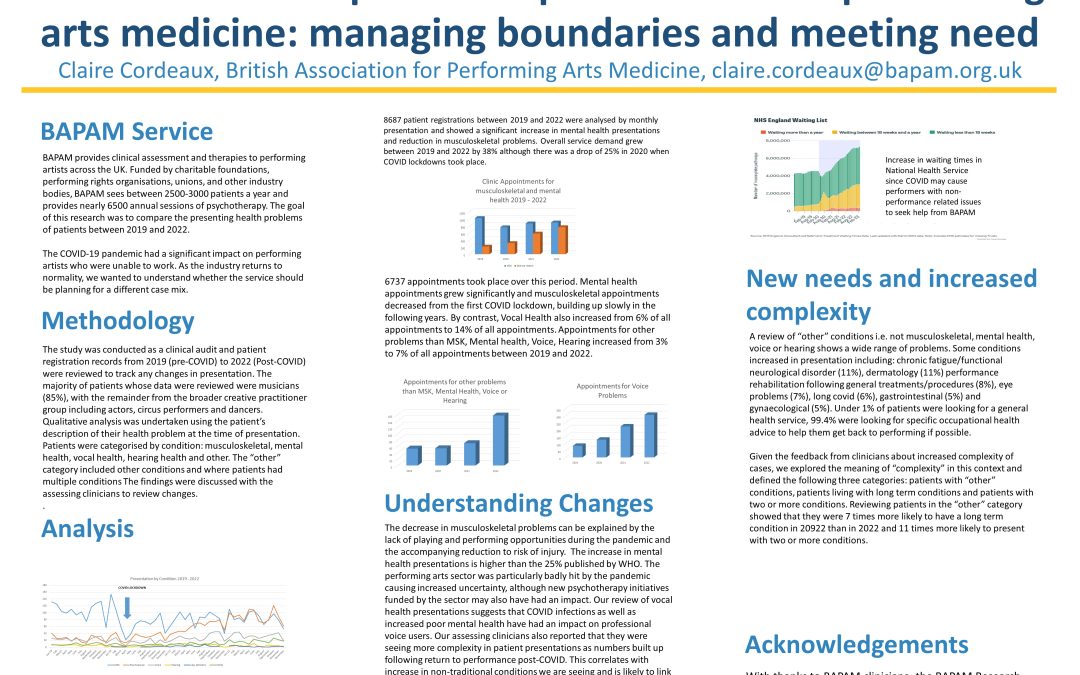BAPAM CEO, Claire Cordeaux presented this poster at the PAMA (Performing Arts Medicine Association) Symposium in New York, July 2023. A downloadable pdf version is available here
BAPAM Service
BAPAM provides clinical assessment and therapies to performing artists across the UK. Funded by charitable foundations, performing rights organisations, unions, and other industry bodies, BAPAM sees between 2500-3000 patients a year and provides nearly 6500 annual sessions of psychotherapy. The goal of this research was to compare the presenting health problems of patients between 2019 and 2022.
The COVID-19 pandemic had a significant impact on performing artists who were unable to work. As the industry returns to normality, we wanted to understand whether the service should be planning for a different case mix.
Methodology
The study was conducted as a clinical audit and patient registration records from 2019 (pre-COVID) to 2022 (Post-COVID) were reviewed to track any changes in presentation. The majority of patients whose data were reviewed were musicians (85%), with the remainder from the broader creative practitioner group including actors, circus performers and dancers. Qualitative analysis was undertaken using the patient’s description of their health problem at the time of presentation. Patients were categorised by condition: musculoskeletal, mental health, vocal health, hearing health and other. The “other” category included other conditions and where patients had multiple conditions The findings were discussed with the assessing clinicians to review changes.
Analysis
8687 patient registrations between 2019 and 2022 were analysed by monthly presentation and showed a significant increase in mental health presentations and reduction in musculoskeletal problems. Overall service demand grew between 2019 and 2022 by 38% although there was a drop of 25% in 2020 when COVID lockdowns took place.
6737 appointments took place over this period. Mental health appointments grew significantly and musculoskeletal appointments decreased from the first COVID lockdown, building up slowly in the following years. By contrast, Vocal Health also increased from 6% of all appointments to 14% of all appointments. Appointments for other problems than MSK, Mental health, Voice, Hearing increased from 3% to 7% of all appointments between 2019 and 2022.
Understanding Changes
The decrease in musculoskeletal problems can be explained by the lack of playing and performing opportunities during the pandemic and the accompanying reduction to risk of injury. The increase in mental health presentations is higher than the 25% published by WHO. The performing arts sector was particularly badly hit by the pandemic causing increased uncertainty, although new psychotherapy initiatives funded by the sector may also have had an impact. Our review of vocal health presentations suggests that COVID infections as well as increased poor mental health have had an impact on professional voice users. Our assessing clinicians also reported that they were seeing more complexity in patient presentations as numbers built up following return to performance post-COVID. This correlates with increase in non-traditional conditions we are seeing and is likely to link with the increasing waiting times in the NHS where these conditions would usually be treated in 18 weeks.
New Needs and Increased Complexity
A review of “other” conditions i.e. not musculoskeletal, mental health, voice or hearing shows a wide range of problems. Some conditions increased in presentation including: chronic fatigue/functional neurological disorder (11%), dermatology (11%) performance rehabilitation following general treatments/procedures (8%), eye problems (7%), long covid (6%), gastrointestinal (5%) and gynaecological (5%). Under 1% of patients were looking for a general health service, 99.4% were looking for specific occupational health advice to help them get back to performing if possible.
Given the feedback from clinicians about increased complexity of cases, we explored the meaning of “complexity” in this context and defined the following three categories: patients with “other” conditions, patients living with long term conditions and patients with two or more conditions. Reviewing patients in the “other” category showed that they were 7 times more likely to have a long term condition in 20922 than in 2022 and 11 times more likely to present with two or more conditions.
Acknowledgements
With thanks to BAPAM clinicians, the BAPAM Research Working Group and the BAPAM team.

